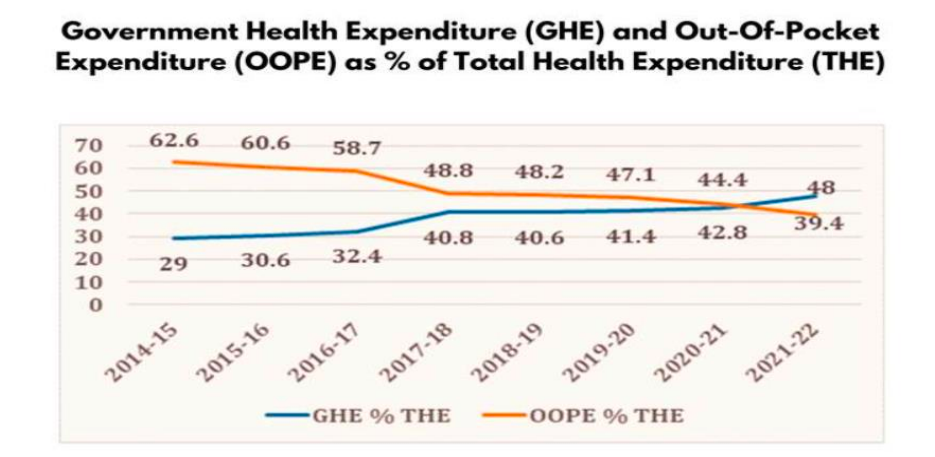The Decline in Out-of-Pocket Expenditure (OOPE) in Health in India
(Source – https://pib.gov.in/PressReleseDetail.aspx?PRID=2072149®=3&lang=1 )
| Topic: GS2 – Social Justice – Health |
| Context |
| ● The article discusses the decline in Out-of-Pocket Expenditure (OOPE) on healthcare in India, attributed to increased government spending and improved public healthcare infrastructure.
● Between 2014-15 and 2021-22, government health expenditure rose significantly, leading to better accessibility and affordability of healthcare. ● This trend highlights India’s progress toward Universal Health Coverage. |
Understanding Out-of-Pocket Expenditure (OOPE)
- OOPE refers to direct payments for medical services, including doctor visits, medicines, and hospital stays.
- High OOPE is a financial burden, especially for low-income families, leading to poverty and debt.
- High OOPE discourages timely medical help, resulting in worsening health conditions and higher treatment costs.
- The government has worked to reduce OOPE through increased public healthcare investments and expanding health insurance coverage.
| Positive Trends in Healthcare Expenditure |
| ● NHA data for 2021-22 shows a reduction in OOPE, attributed to increased government investment in public healthcare.
● Government Health Expenditure (GHE) as a percentage of GDP rose from 1.13% in 2014-15 to 1.84% in 2021-22. ● GHE’s share of overall government spending grew from 3.94% to 6.12% during the same period. ● Per capita health spending increased from ₹1,108 to ₹3,169 between 2014-15 and 2021-22. ● Increased funding allowed for strengthening public healthcare services, making healthcare more accessible and affordable, thus reducing OOPE.\
|
Key Reasons for the Decline in OOPE
- Increased Government Health Expenditure (GHE):
- GHE increased from 1.13% to 1.84% of GDP between 2014-15 and 2021-22, improving healthcare accessibility and affordability.
- Expansion of Social Security Expenditure (SSE):
- SSE on healthcare rose from 5.7% of Total Health Expenditure (THE) in 2014-15 to 8.7% in 2021-22, protecting individuals from catastrophic health expenses.
- Growth of Government-Funded Insurance Schemes:
- Programs like Ayushman Bharat and state-level health insurance schemes helped reduce the reliance on personal finances for healthcare.
- Focus on Public Health Infrastructure:
- Increased investment in healthcare infrastructure and workforce development, especially in underserved areas has improved service availability and affordability.
- Targeted Programs for Non-Communicable Diseases (NCDs):
- Government programs to manage and prevent NCDs reduced the financial burden on patients.
- COVID-19 Response:
- The pandemic led to greater investments in public healthcare, addressing immediate needs and laying a foundation for long-term reduction in OOPE.
Implications of Reduced OOPE
- Improved Healthcare Accessibility:
- Reduced OOPE makes healthcare services more affordable, encouraging individuals to seek medical care without financial worries.
- Stronger Public Healthcare System:
- Lower OOPE allows the public healthcare system to cater to a broader population and distribute resources more equitably.
- Better Health Outcomes:
- Affordable healthcare enables individuals to seek timely care, reducing the severity of illnesses and improving overall health outcomes.
- Increased Financial Stability for Households:
- With less money spent on healthcare, families can allocate resources toward other essential needs, improving their financial stability.
- Foundation for Universal Health Coverage (UHC):
- The reduction in OOPE supports India’s long-term goal of achieving Universal Health Coverage, ensuring healthcare access as a right for all citizens.
Conclusion
- The decline in OOPE reflects India’s commitment to improving healthcare accessibility, public health resilience, and moving toward Universal Health Coverage.
- Continued government investment in healthcare will help ensure that quality medical services are available to all, regardless of income.
| Practice Question: “Out-of-Pocket Expenditure (OOPE) has been a significant barrier to healthcare access in India. Analyse the recent trends in government health expenditure and its impact on reducing OOPE. (250 Words /15 marks) |

